The odds that the United States will fall into a recession at some point over the next 12 months have risen to a 40-year high, according to a probability model from the New York Federal Reserve.
The Fed’s recession risk indicator is now greater than it was in November 2007, not long before the subprime crisis, when it stood at 40 percent.
The recession model is based on the spread between the three-month and 10-year yields on U.S. Treasurys.
For months, the U.S. economy had been projected to show slowing real GDP growth and labor market softening.
Amid the banking sector turmoil sparked by the collapse of Silicon Valley Bank, economists at the Federal Reserve have projected a shallow recession.
There has been a growing chorus of experts who believe that the odds of a recession are high.
Former Treasury Secretary Larry Summers said he thinks the chances are “probably about 70 percent.”
“As I put together the lags associated with monetary policy, the credit crunch risks, the need for continuing action around inflation, the risk of geopolitical or other shocks affecting commodities, 70 percent would be the range that I would be in.”
A recent poll showed that most Americans believe that the country is headed for a recession—or has already fallen into an economic downturn.
The survey showed that 69 percent of U.S. adults have negative views about the current economic landscape, which is the highest figure since the survey began 17 years ago.
Debt Ceiling Deadlock
The Treasury Department has warned that the United States could default as soon as June 1 if no deal is reached.The White House has put out an analysis that said even a “short” default could eliminate half a million jobs and that a “protracted” one could cost 8.3 million jobs.
When the United States reached the $31.4 trillion debt cap in January, the Treasury Department started resorting to “extraordinary measures” to keep making payments on outstanding federal debt obligations and keep the government from defaulting.
At some point, however, the scope to continue with those accounting maneuvers will run out and the government will face the prospect of being unable to meet its financial obligations—a moment known as the X-date.
When the X-date is reached and there’s no agreement in Congress to lift the cap, the Treasury Department will be unable to issue any more bills, bonds, or notes and can only make payments on the government’s debt obligations from incoming tax revenues.
After a three-month hiatus, negotiations on raising the debt cap resumed on May 9 between President Joe Biden and House Speaker Kevin McCarthy (R-Calif.), but they ended with no breakthrough.
Biden has insisted on a clean bill to raise the borrowing limit, while McCarthy and House Republicans have put forward a proposal that would pair lifting the cap by $1.5 trillion with $4.5 trillion in spending cuts over a decade. The president has rejected the GOP proposal and vowed to veto it if it reaches his desk.





